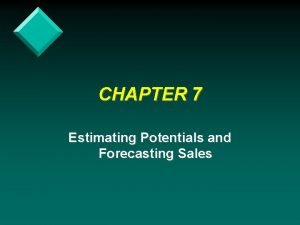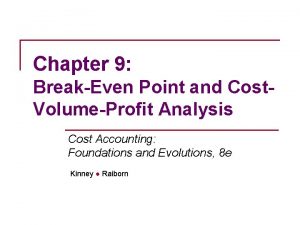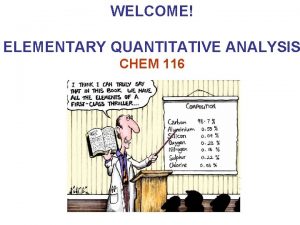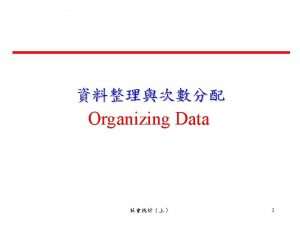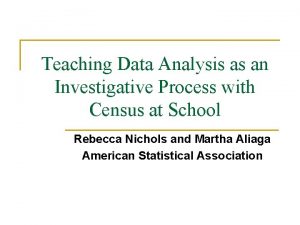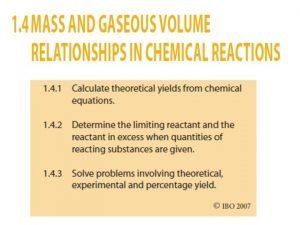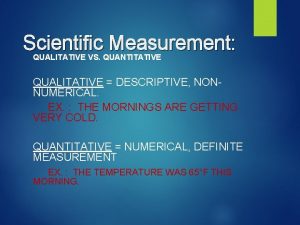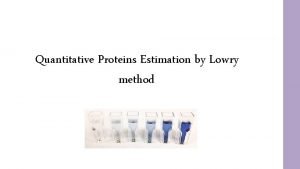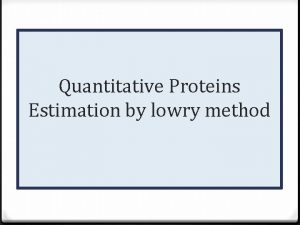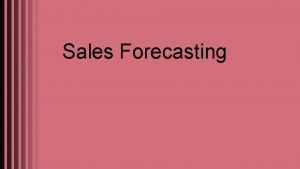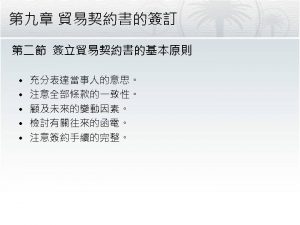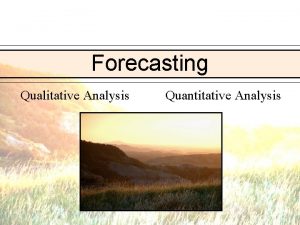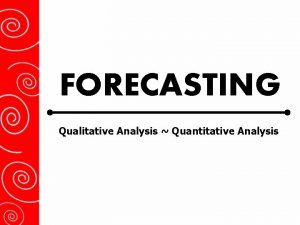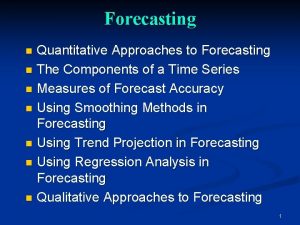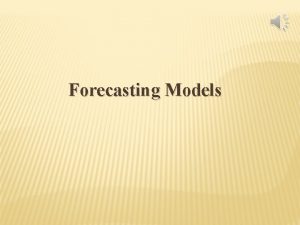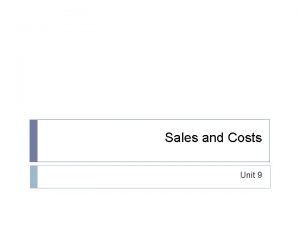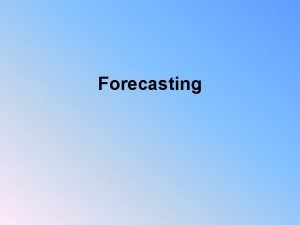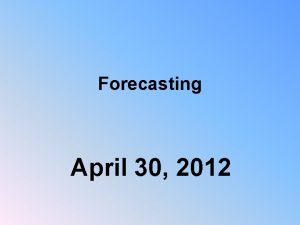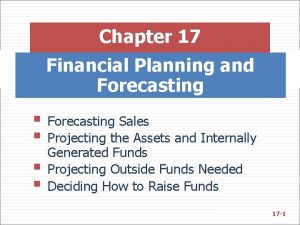SALES FORECASTING UNIT 4 3 SALES FORECASTING Quantitative







































- Slides: 39

SALES FORECASTING UNIT 4. 3

SALES FORECASTING • Quantitative management technique used to predict a firm’s level of sales over a given time period. • It can help the firm identify problems and opportunities in advance. • Forecasts may turn out to be completely inaccurate because trying to predict what will happen in the future is difficult.

SALES FORECASTING TECHNIQUES • Extrapolation • Market research • Time series analysis

EXTRAPOLATION • This identifies the trend by using past data and extending this trend to predict future sales. • This method is only useful if predictions apply to the near future. • This technique works well if there is a clear correlation (relationship) between two sets of numbers, such as sales revenue over a period of time or the correlation between marketing expenditure and sales growth.

EXTRAPOLATION

MARKET RESEARCH • Identifying and forecasting the buying habits of consumers can be vital to a firm’s prosperity and survival. • When the business become complacent, they may fail to recognize the changing demands of customers. • Ex. General Motors (GM) despite being the top global producers of cars for 76 years, GM grew complacent and overproduced cars, failing to recognize the changing demands of customers. • Ex. Toyota took over the top motor manufacturer in 2006, with its highly successful fuel efficient and hybrid vehicles. This is their response to soaring oil prices and greater concerns for the environment.

TIME SERIES ANALYSIS • This is a quantitative sales forecasting method that predicts future sales levels from past sales data. • It relies on time series data, which is sales information that businesses have kept over a given period since it occurred. • The business then rely on this past data in an attempt to predict the future. • Elements of this time series analysis: • Seasonal variations • Cyclical variations • Random variations

SEASONAL VARIATIONS • These are changes in demand because of the varying seasons in the year. • An example is when a business experiences an increase in sales of clothing at the beginning of a new year but experiences a decline in sales in the middle of the year. • Seasonal variations are usually repeated and occur within one year or less.

CYCLICAL VARIATIONS • These are variations tied to the business cycle in an economy. • For examples, sales could be on the rise during the growth phase but declining during a recession. • Cyclical variations can extend to more than one year.

RANDOM VARIATIONS • These are notable changes or fluctuations that stand out from a given trend. • For example, there may be a sudden increase in demand for ice-cream during a rare warm day in winter. • Random variations are unpredictable and can occur at any time.

FACTORS TO CONSIDER WHEN CHOOSING THE RIGHT TECHNIQUE • How accurate the forecasts need to be – the greater the degree of certainty needed, the more thorough the methods of sales forecasting need to be. • How far ahead forecasts need to be – it is relatively easy to forecast sales for the next day, week or month. It is more difficult to predict sales levels over the next several years.

FACTORS TO CONSIDER WHEN CHOOSING THE RIGHT TECHNIQUE • The availability and cost of data and information collection – if there is a widespread access to a wealth of information at no or very little cost, then this can make forecasting more accurate. • The stage in a product’s life cycle – Market research rather than time series analysis will be used during both the ‘R&D’ and ‘Launch’ stages. More data and information become available during the growth and maturity stages.

STATISTICAL TECHNIQUES USED TO ANALYZE SALES FORECASTING DATA • Mean • the arithmetic mean is the sum of all items divided by the number of items in a data set. • Median • When all number are ranked in numerical order, the median is the middle number in the data set. • Mode • This is the number that occurs more frequently than any other value in the data set. • Range • This is the numerical difference between the highest and lowest numbers in a data set. • Standard deviation • This measures the difference (or digression) of a variable from the mean value in a data set. (see http: //www. investopedia. com/terms/s/standarddeviation. asp)

MOVING AVERAGES (MA) • The most frequently used method of calculating averages is the arithmetic mean. • Moving averages are a more accurate method of identifying trends so they are a more useful tool for sales forecasting. • MA is used to establish underlying trends by smoothing out variations in the data set that are caused by seasonal, cyclical and random variations.

CALCULATING A 3 -YEAR MA • Work out the mean for the first three data items • Repeat this for the next three data items • Continue this process for the final three data items

Exam Tip! Worked example - Page 368 n Given that most new products fail to get established on the market, this implies that businesses often over predict their sales, ie. sales forecasting is not an exact science and you need to be aware of the limitations. n

CALCULATING A 4 -YEAR MA • Work out the mean for the first four data items • Repeat this for the next four data items • Continue this process for the final four data items • See table 4. 3. c – page 368

MOVING AVERAGE

MOVING AVERAGE ADVANTAGES DISADVANTAGES • Useful for identifying and applying the seasonal variation to predictions. • Reasonably accurate for short-term forecasts in reasonably stable economic conditions. • Identifies the average seasonal variations for each time period and this can assist in planning for each quarter in future. • Fairly complex calculation. • Forecasts further into the future become less accurate as the projections made are entirely based on past data. • Forecasting for the longer term may require the use of more qualitative methods that are less dependent on past results.

Exam Tip! n When analyzing sales forecasts, make sure you can calculate percentage changes to show what has happened to sales revenue during the time period given. This can help to improve your argument. To calculate percentage changes, work out the numerical difference and divide this by the original number and express as a percentage, (new figure – old figure) / old figure x 100.

BENEFITS OF SALES FORECASTING • If marketing managers were able to predict the future accurately, the risk of business operations would be much reduced. • If a precise forecast of monthly sales over the next two years could be made, the benefits to the whole organization would be immense.

BENEFITS OF SALES FORECASTING • The production department would know how many units to produce and what quantity of materials to order and would hold the correct level of stocks. • The marketing department would be aware of how many products to distribute and whether changes to the existing marketing mix were needed to increase sales.

BENEFITS OF SALES FORECASTING • Human resources workforce plan would be more accurate, leading to the appropriate level of staffing. • Finance could plan cash flows with much greater accuracy.

LIMITATIONS OF SALES FORECASTING • Limited information • Is a prediction based on past data and trends • Does not reveal the whole picture (as the tool is based on assumptions) without any consideration of qualitative factors • Forecasts are only as good as the information and data that are available at the time the forecasts are made

LIMITATIONS OF SALES FORECASTING • Inaccuracy of predictions • There can be an element of bias or subjectivity in sales forecasting • Even accurate sales forecasts are based on assumption • Figures used might be overly optimistic • Past trends are not indicative of the future • Having no or limited historical data can make sales forecasting extremely difficult or inaccurate

LIMITATIONS OF SALES FORECASTING • Garbage in garbage out (GIGO) • If the data and information used to predict sales forecasts are outdated, irrelevant or biased, then the forecasts are unrealistic. • For example: some managers might deliberately underestimate sales forecasts so that it is easier to reach their targets.

LIMITATIONS OF SALES FORECASTING • External influences • The external business environment (unit 1. 5) causes change that may not be predictable (ie. natural disasters, oil price hikes, fierce competition from abroad, unexpected fluctuations in the business cycle or adverse weather conditions. • Such factors can significantly distort sales forecasts.

Common Mistake n Some students are often quick to condemn the skills of sales forecasters, stating that the data collected is either biased or unrepresentative. Sales forecasting techniques can be extremely sophisticated (beyond the scope of your IB exams) and give reliable data for marketers. Of course, if actual sales figures vary significantly from the forecasts then questions should be asked; but don’t assume that sales forecasts are unreliable simply because they don’t match the predicted figures.

CUEGIS PAGE 373

Homework Questions 4. 3. 1 – 4. 3. 4

Key terms review

Correlation • Shows the degree to which two sets of numbers or variables are related, e. g. sales revenue over a period of time. Marketers are interested in establishing a strong correlation between marketing expenditure and sales growth.

Cyclical variations • Are recurrent fluctuations in sales linked to the economic cycle of booms and slumps. Unlike seasonal variations, this type of variation can last longer than a year.

Extrapolation • Is a forecasting technique used to identify the trend by using past data and extending this trend to predict future sales.

Moving averages • Are used to find underlying trends by smoothing out variations in a data set caused by seasonal, cyclical and random variations.

Sales forecasting • Is a quantitative management technique used to predict a firm’s level of sales over a given time period.

Seasonal variations • Are periodic fluctuations in sales revenue over a specified time period, such as certain months or quarters of the year.

Random variations • Are unpredictable fluctuations in sales revenue caused by erratic and irregular factors that cannot be practically anticipated.

Time series analysis • Is a sales forecasting technique that attempts to predict sales level by identifying the underlying trend from a sequence of actual sales figures.
 Rumus least square
Rumus least square Demand forecasting and replenishment
Demand forecasting and replenishment Unit 10, unit 10 review tests, unit 10 general test
Unit 10, unit 10 review tests, unit 10 general test Scatter plotting in hrm
Scatter plotting in hrm Sales organizational structure
Sales organizational structure Discuss the nuances of sales letters.
Discuss the nuances of sales letters. Sales potential vs sales forecast
Sales potential vs sales forecast Selling organization
Selling organization Management of sales territories and quotas
Management of sales territories and quotas Target profit formula
Target profit formula Surplus keuangan adalah
Surplus keuangan adalah Right triangle trigonometry examples
Right triangle trigonometry examples English system conversion
English system conversion Algebra 2 unit 1 test answers
Algebra 2 unit 1 test answers Contoh kebutuhan mengitung unit cos unit kerja rekam medis
Contoh kebutuhan mengitung unit cos unit kerja rekam medis Unit process and unit operation
Unit process and unit operation Difference between unit process and unit operation
Difference between unit process and unit operation Kerangka konseptual standar akuntansi pemerintahan
Kerangka konseptual standar akuntansi pemerintahan What is qualitative data in geography
What is qualitative data in geography Qualitative research is viewed in a holistic perspective
Qualitative research is viewed in a holistic perspective Longitudinal study qualitative or quantitative
Longitudinal study qualitative or quantitative Quantitative analysis definition
Quantitative analysis definition Quantitative variable 中文
Quantitative variable 中文 Objectives of comparative education
Objectives of comparative education Ualitative
Ualitative Pixl knowit gcse chemistry chemical changes
Pixl knowit gcse chemistry chemical changes Quantitative easing for dummies
Quantitative easing for dummies Quantitative variable examples
Quantitative variable examples Quantitative study of reactants and products
Quantitative study of reactants and products Stoichiometry is defined as the quantitative study of
Stoichiometry is defined as the quantitative study of Qualitative vs quantitative measurements
Qualitative vs quantitative measurements Sampling methods in qualitative and quantitative research
Sampling methods in qualitative and quantitative research Methodology in research
Methodology in research Quantitative research examples
Quantitative research examples Descriptive correlational research design
Descriptive correlational research design Descriptive research meaning
Descriptive research meaning Qualitative and quantitative data analysis
Qualitative and quantitative data analysis Qualitative traits vs quantitative traits
Qualitative traits vs quantitative traits Quantitative estimation of protein
Quantitative estimation of protein Protein estimation by lowry method
Protein estimation by lowry method






